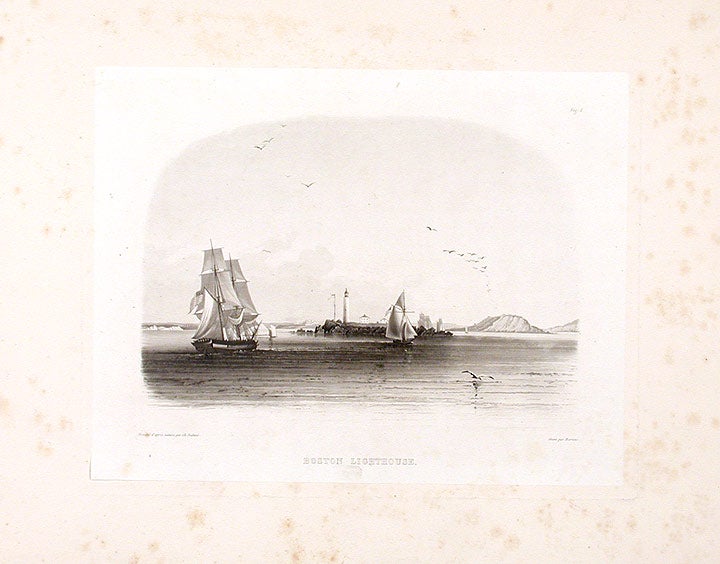BODMER, Karl (1809-1893)
Boston Lighthouse
[Vig. 1] [Paris, Coblenz and London: [1839-1842]. Aquatint engraving by Martens after Bodmer, proof on india paper mounted, issue with no imprint and no titles in French or German, blindstamp. Tear to lower blank margin not affecting plate area, mount spotted. Sheet size: 12 1/2 x 17 5/8 inches. Plate mark: 8 1/2 x 11 inches.
A rare India proof of this evocative scene recalling Bodmer's arrival at his gateway to the New World: the American brig Janus, with Bodmer and Prince Maximilian aboard, is here seen at the end of the relatively perilous Atlantic crossing, passing the lighthouse and making its way into Boston harbour. It is the morning of 4th July 1832 and the explorers are greeted by the cry of wheeling sea-birds, perhaps roused by the sound of the cannons being fired in the distance, in celebration of the United States fifty-sixth anniversary of Independence. Karl Bodmer's images show great versatility and technical virtuosity and give us a uniquely accomplished and detailed picture of a previously little understood (and soon to vanish) way of life. Swiss-born Bodmer was engaged by Prince Maximilian zu Wied-Neuwied (1782-1867) specifically to provide a record of his travels in North America, principally among the Plains Indians. In the company of David Dreidoppel (Prince Maximilian's servant and hunting companion), their travels in North America were to last from 1832 to 1834. They arrived in Boston in July 1832, traveled on to Philadelphia, where they stayed with Napoleon Bonaparte's elder brother Joseph. From here they headed west across Pennsylvania across the Alleghenies to Pittsburgh and the Ohio country, visiting all the important German settlements en route. Their most important stop on their route west was at the utopian colony of New Harmony in Indiana. The Prince spent five months there in the company of some of the countries leading scientific men, and studying all the relevant literature on backcountry America. On 24 March 1833 the party reached St. Louis, Missouri, and the start of the journey into Indian country. Well-armed with information and advice, the party finally left St.Louis aboard the steamer Yellow Stone on April 10 1833. They proceeded up the treacherous Missouri River along the line of forts established by the American Fur Company. At Bellevue they encountered their first Indians, then went on to make contact with the Sioux tribe, learning of and recording their little known ceremonial dances and powerful pride and dignity. Transferring from the Yellow Stone to another steamer, the Assinboine, they continued to Fort Clark, visiting there the Mandan, Mintari and Crow tribes, then the Assinboins at Fort Union, the main base of the American Fur Company. On a necessarily much smaller vessel they journeyed through the extraordinary geological scenery of that section of the Missouri to Fort Mackenzie in Montana, establishing a cautious friendship with the fearsome Blackfeet. From this, the westernmost point reached, it was considered too dangerous to continue and the return journey downstream began. The winter brought its own difficulties and discomforts, but Bodmer was still able to execute numerous studies of villages, dances and especially the people, who were often both intrigued and delighted by his work. The portraits are particularly notable for their capturing of individual personalities, as well as forming a primary account of what was to become virtually lost cultures.
Graff 4648; Howes M443a; Pilling 2521; Sabin 47014; Wagner-Camp 76:1.
Item #15628
Price: $650.00


